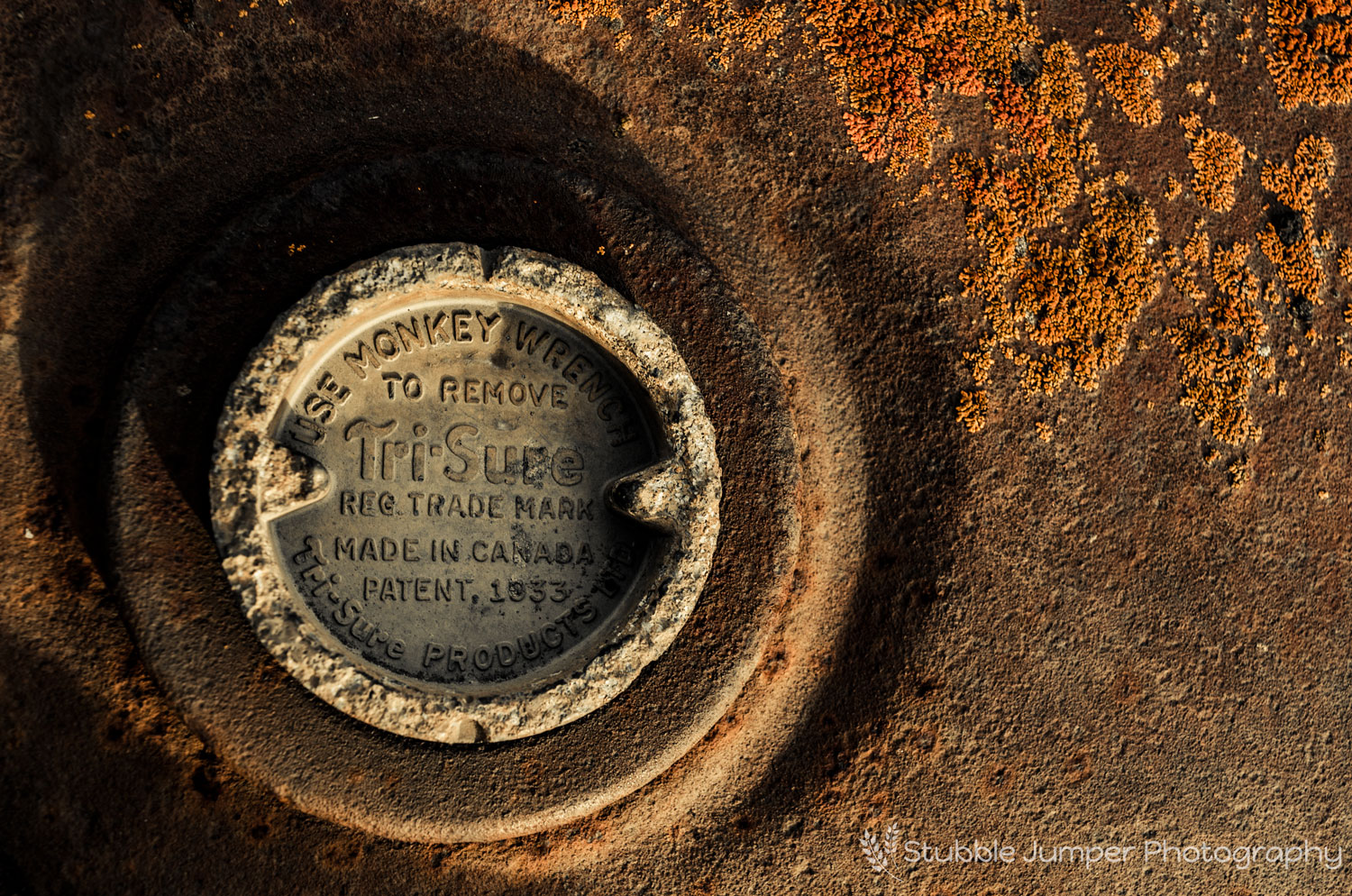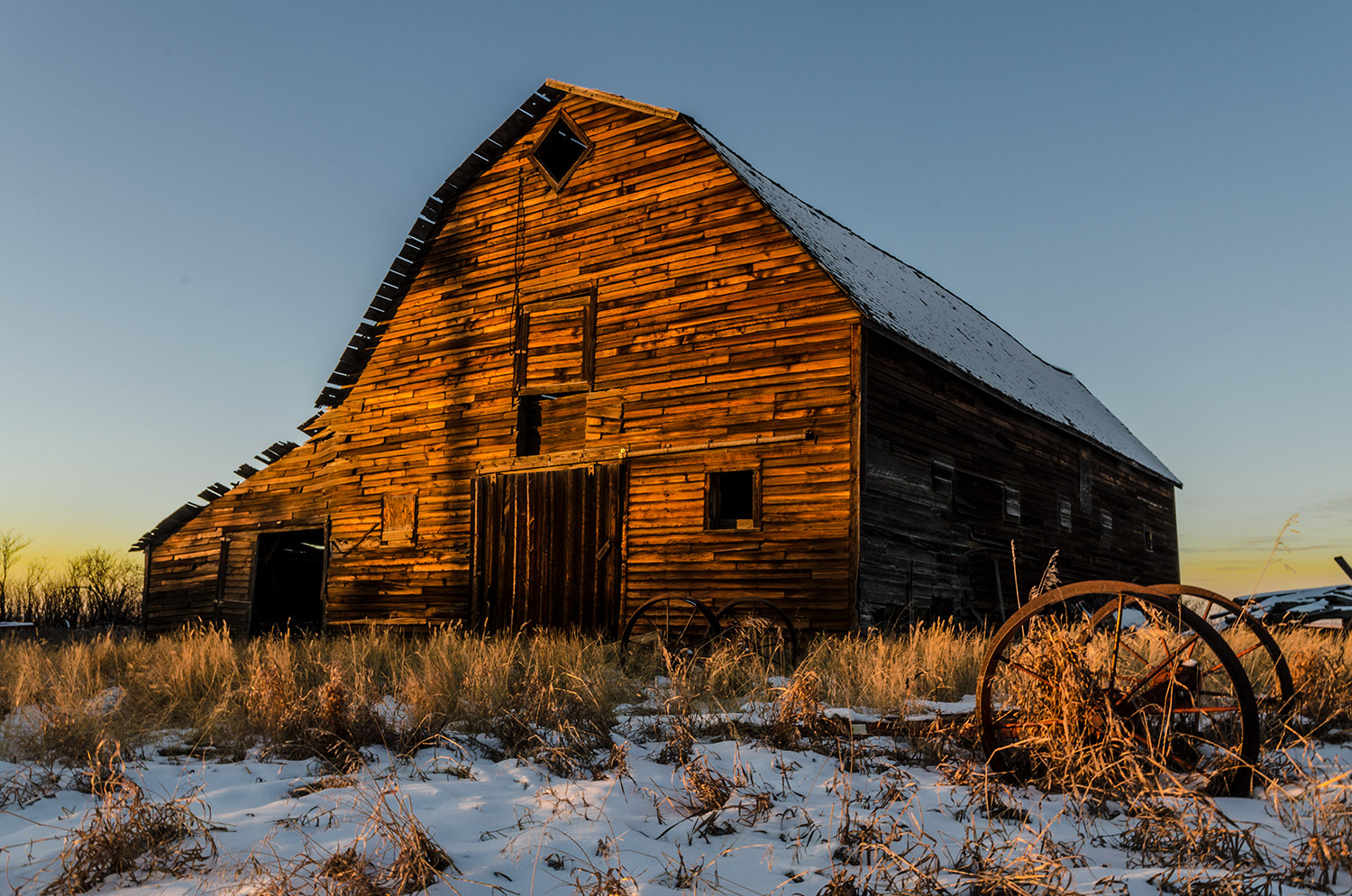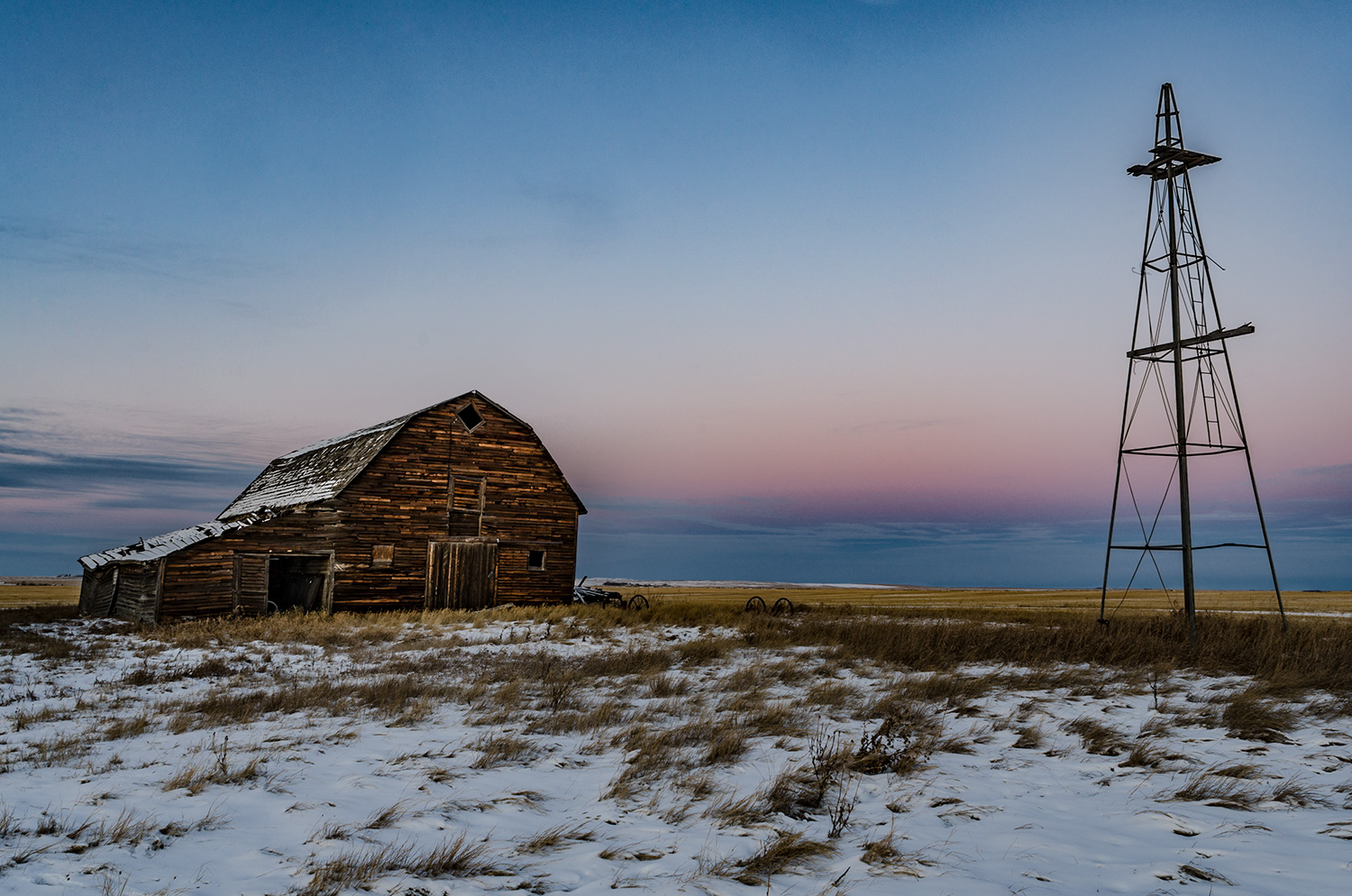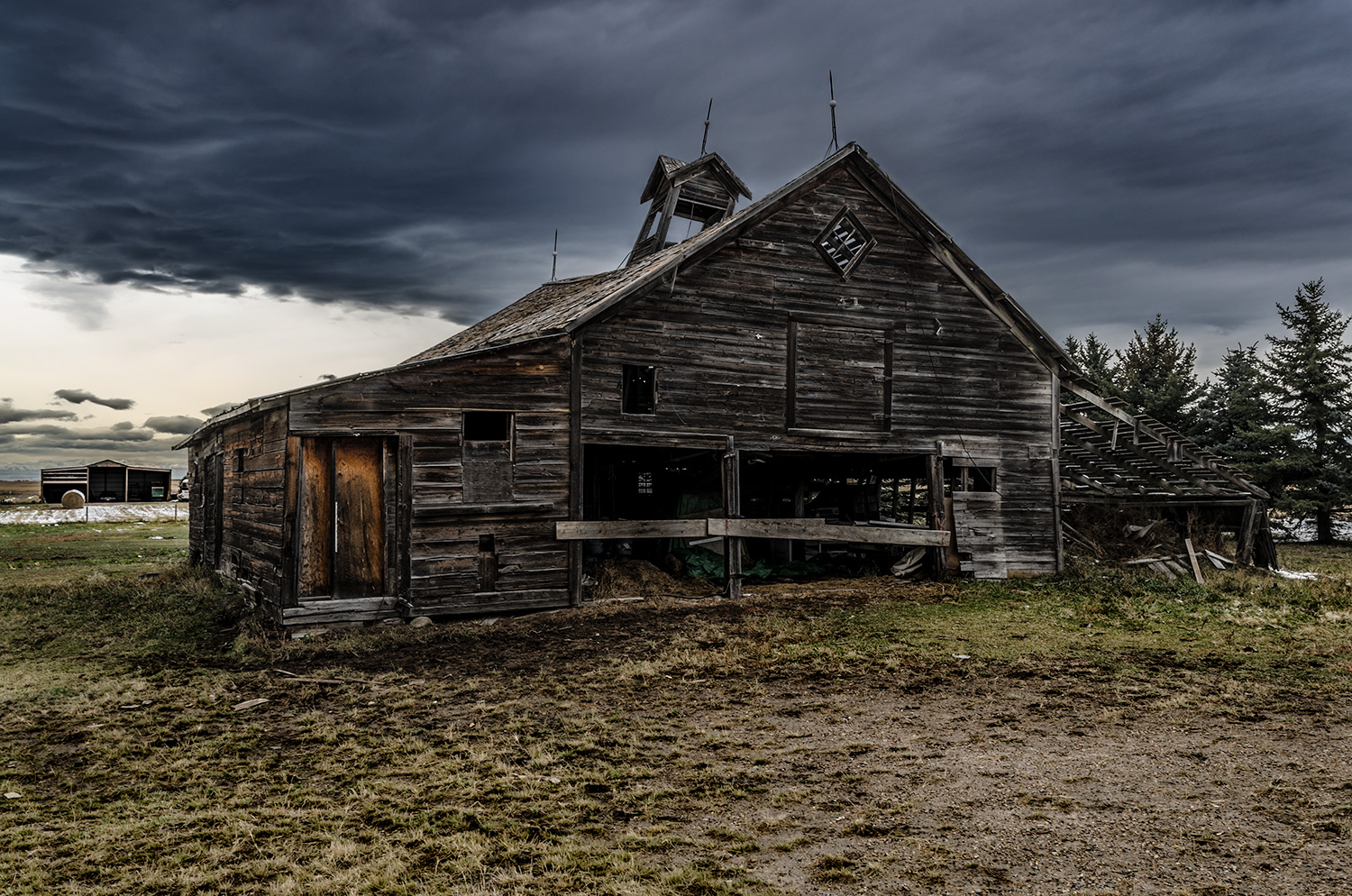The original homesteaders on this land came from Denmark. The farm was passed down in the Nielsen family from 1903 until they sold to Bob Penner in 1971. The barn was built in 1914 as part of a mixed farming operation. From 1914 to the end of 1941 the barn was used for the horses that worked the land. In later years it was home to dairy cows and hogs. The barn received power in 1947, a cement floor was poured in 1964 and by 1968 the barn was no longer in use. It still stands as a testament to the hard work and determination it took to settle the land.
Sharples
Sharples, Alberta is named after John Sharples, a C.P.R. railway fireman who won the Distinguished Conduct Medal during the First World War. Even though Sharples has always been a small settlement, it handled an exceptional amount of grain. Being located in the picturesque Kneehill Creek valley, Sharples' elevators were vital to farms on the north side of the creek as crossings were few and far between. This P&H elevator was constructed in July of 1923 with a capacity of 28000 bushels. It still wears much of it's original tin siding. The elevator was abandoned in 1982 when the Alberta Wheat Pool elevator (built in 1927 by Alberta Pacific Grain Co.) that stood beside it was demolished. Two annexes were built in the early forties. The one on the west side is still standing and held 26000 bushels. The smaller annex on the east side held 14000 bushels and has disappeared from the scene.
Parrish and Heimbecker was established in 1909 by William Parrish and Norman G. Heimbecker and has grown to be one of the largest grain handling companies in Canada.
International Gray Day
This barn dates from the 1940s with the current owner being in possession since the 50s. An old wagon and a couple of International pick ups are on the property. One truck is from the 1950s and the other from the mid 60s. I had this property on my list, trying to track down the owner and get permission to take photos. I lucked out one day while driving by and found the owner out fixing fences. He let me take a couple of photos and shared some of the history with me. Even though the buildings are no longer in use, he still maintains the property. The grass was cut, the fences in good repair and the windows are still in the buildings. It is amazing how far some maintenance can go in preserving these historic structures. Maybe one day they can be used again.
A Buick And A Half
Here are one and a half late 20's Buicks, resting temporarily before they become yard art.
Automobiles revolutionized personal transportation in the 1920s. Throughout the 20s cars became more accessible and affordable, dawning the 'oil age' in Canada.
In the late teens the Calgary Auto Club assisted in the formation of 25 automobile clubs in Southern Alberta. Edmonton, Lethbridge, and Medicine Hat also assisted in forming auto clubs in communities near the urban centres. The clubs worked toward the further development of highways and good roads throughout the province. By 1929 a total of 833 miles of highway had been graveled.
The popularity of the automobiles gave rise to a thriving do it yourself car repair industry. Canadian Tire being one of the more notable companies, started in Toronto in 1922 and has grown to become one of Canada's largest retailers.
Maple Leaf Barn
This barn was built in 1912 and only fell into disuse about 10 years ago. The builder's grandson still lives on and farms the same land that his ancestors made their living on. Only one of the wooden cupolas still survives on the roof of this very large barn.
What I believe to be a 1948 Maple Leaf badged Chevrolet sits in the farm yard. My research (which may be flawed) tells me the 1947-53 Chevrolet pick ups known as the Advance Design series were the last body style to carry the Maple Leaf badge. Maple leaf trucks were built in Oshawa, Ontario from the 1930s until the 1950s. Right hand drive models were made in Canada and assembled by Holden in Australia. Canada, Australia and other British Commonwealth countries put high tariffs on US built products because the US didn't import much from them. Having a Canadian made truck allowed GM to offer trucks at a more affordable cost.
An Allis Chalmers AC5040 2 wheel drive tractor also sits on the property. These were manufactured in Romania from 1976-1980 with an original price of $9823USD. They were equipped with a 3 cylinder diesel that made 35 horse power.
Golden Hour Barn
The current landowners acquired this property in 1960. By that time all of the buildings had fallen out of use. By the late 1970's the house and other buildings had to be demolished after descending into disrepair due to vandalism. The shed on the side of the barn looks ready to fall but, the barn itself appears remarkably stable from the outside. It is believed that the barn was built sometime between 1905 and 1910.
Future Classics?
Here is another great Southern Alberta barn. The owner tells me it is at least 100 years old and hasn't been in use for quite some time. It is strange to see so many newer vehicles abandoned behind the barn. I wonder if any will ever become as collectible as the vehicles we currently consider classics?
Our Country And Its People
This is the book mentioned in my last post - 'Woodley Barn'. Published in 1938 'Our Country And Its People' was part of grade 7 Social Studies in Alberta schools. The authors wrote of Canada's natural beauty, our abundant resources, the settlers and their homelands. It is interesting to read about our history from a past perspective.
Woodley Barn
With the rocky mountains stretching across the western horizon, this barn and house were built in 1912 on a scenic piece of the Alberta prairie. The current owners, the Woodleys, acquired the land in 2010. They were happy to let me take photos, creating memories of a structure that may fall after a couple of heavy snows. They gifted me a book that was found in the house titled “Our Country And Its' People” by W.D. McDougall and Gilbert Paterson . Inside the book, I found clippings containing information on some of the animals that were found in the area. I can imagine the owner studying the area before his long, difficult journey to the place he and his family would call home for generations to come. The Woodleys purchased the land from an elderly lady who didn't have any remaining family, so many of the details are now lost to time.
Dorothy Elevator
This photo is included for the month of November in this year's Alberta Motor Association calendar. I took the shot on the morning of Christmas eve, during the unusually warm winter of 2014. On July 22, 2015 a storm ripped the roof off of the elevator and damaged other structures in the hamlet of Dorothy, Alberta.
The Alberta Pacific elevator was built in 1928, alongside two others. An Alberta Wheat Pool and a United Grain Growers elevator completed the row of three. After the last train went through, the elevator fell into disuse. Although it's future is uncertain, the elevator still stands as a reminder of the past and serves as an iconic landmark as you leave the Red Deer River valley, heading East on highway 570. Here's hoping that this historic piece of our prairie heritage will be preserved.

















































